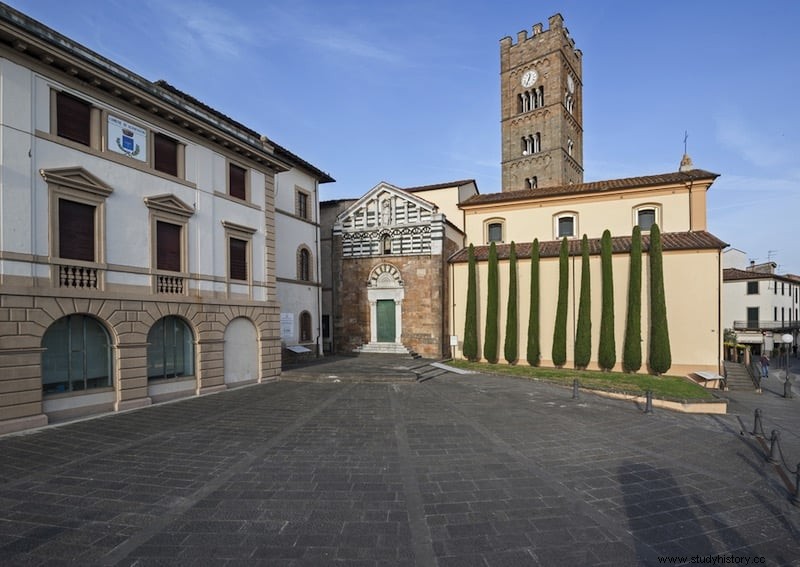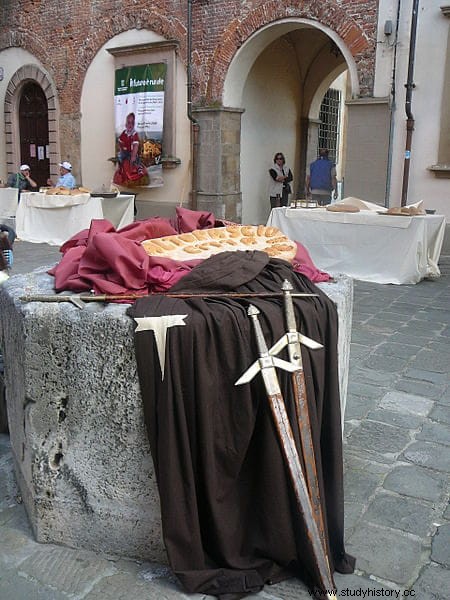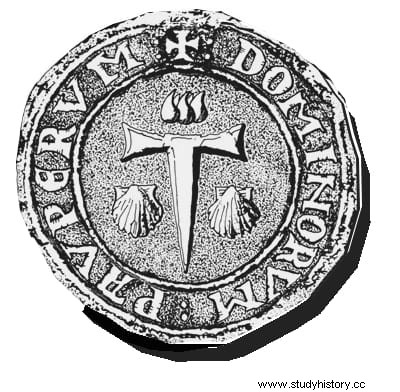When one thinks of chivalric military orders of the medieval era, the first names that come to mind are the Templars, the Hospitallers, the Teutonic Knights... they are the ones that accumulated the most power, the most famous and well-known, thanks to multiple studies, books, movies and comics. In Spain we also have the Order of Calatrava and that of Santiago, which despite their local importance, never managed to have much projection in the rest of Europe. But there is an order that is certainly little known but that is of great importance for being the first of all the religious-military orders that emerged in Europe in the Middle Ages. It was officially called the Order of Santiago de Altopascio (some authors such as Manuel Boix prefer the literal San Jaime de Altopascio), but it was better known for the shape of the cross they carried on their shields and clothing:the Knights of the Tau .
Its formation is shrouded in legend, but there is a general consensus among historians that it must have occurred sometime in the year 1060-1061, in a small town in Tuscany called Altopascio located about 14 kilometers southeast of Lucca. In those days the road that connected the south of France and the north of Italy with Rome was the Via Francigena. It crossed a thick forest near Lake Bientina, narrowing it and making transit difficult, but at the same time constituting a perfect place for the combination of bandits and natural hazards to make this section an ordeal for unsuspecting travelers and pilgrims.

The legends about the founding of the order have to do with it, as Frank McArdie tells in his study on Altopascio. The first attributes its foundation to the Grand Countess Matilde de Canossa , the most powerful woman in Europe at the time, who came to control all the territories north of the Papal States, mainly because of her close alliance with the pope. To get an idea of her importance, it is enough to mention that she is one of the only 4 women who are buried in the Basilica of Saint Peter in the Vatican. Matilda would have gotten lost in the woods and that experience would later lead her to sponsor the creation of a hospital where pilgrims could spend the night safely. The story is completed with the installation of a bell called la Smarrita (the loss ), which rang for an hour between one and two in the morning, so that those who had gotten lost could follow its sound to the shelter.
The other story about the origin of the order, this time included even in its statutes and therefore more plausible, is that it is due to 12 monks who moved to Altopascio from Pozzevoli to open the hospital in 1061. There they organized themselves as a community religious-military, three decades before the Crusades, which was dedicated to the defense of pilgrims, and little by little their number increased with knights, clerics and laity.

Finally, in 1239, Pope Gregory IX conferred on them the Rule of the Hospital of Santiago de Altopascio, similar to that of the Hospital of San Juan de Jerusalem, at a time when its influence had already spread throughout Europe, and in the following century it would reach so famous that it is even mentioned in Boccaccio's Decameron, written in 1353. Their work in the Holy Land was nothing more than anecdotal, since they were more concerned with expanding throughout Europe, where they established foundations in many countries. In Spain they founded three hospitals, one in La Font del Perelló, another in Astorga and the third in Pamplona.
This growing influence did not fail to make them enemies and so in 1330 all the Knights of the Tau in France were arrested and their property confiscated, as had happened to the Knights of the Temple 23 years earlier. In 1459 Pope Pius II tried to suppress the order, arguing that it was no longer fulfilling its mission, ordering that its possessions be passed, along with those of 6 other suppressed orders, to the new Order of Our Lady of Bethlehem. This had been created by the pontiff himself with the aim of defending the island of Lemnos, but it barely lasted and in reality the transfer of properties never took place.

The Order of Santiago de Altopascio continued to exist in Italy until 1587, when Sixtus V integrated it into the Order of Saint Stephen, which continues to exist today. In France, where they had managed to recover from the raid of 1330, it still remained independent until 1672, finally being absorbed into the order of Saint Lazarus of Jerusalem.
As we said at the beginning, the popular name by which the order was known was the Knights of the Tau. The reason is that their symbol was that letter, which they carried on their shields in white on a black background, understood as a Tau Cross, which is also the symbol of the Franciscan order, and corresponds to the last letter of the Hebrew alphabet.
Today there is a society of Knights of the Tau Cross in Altopascio, which calls itself a reconstituted order, and at the same time the French, British and Scottish branches of the order are grouped under the name of Order of Santiago de Altopascio included in the Order of the Fleur de Lis, although obviously, they are continuations of the original is debatable.
